Visit to the C. F. Martin Factory, October 2009
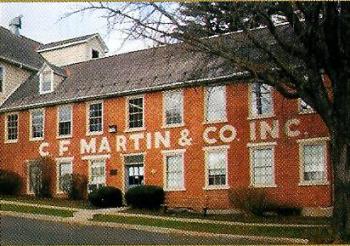
♪ My wife and I had the pleasure of a visit to the Martin Guitar Factory a few weeks ago. This had been on my “To Do” list for a very long time but just never before bubbled up to the surface. We tied it in with a visit to Gettysburg (another long standing list item) and also with visits with two friends I served with 36 years ago in Africa. Lots of history to catch up with at all of these destinations, especially with the old friends.
♪ The factory is located in the quaint little town of Nazareth PA., a suburb of the not nearly as quaint Allentown. Drive time from Rochester is about four and a half hours, all on good highway and with a very scenic section near the Poconos.
The 10 second history: C.F Martin learned the luthier’s trade in Germany in the early 1800’s and emigrated to New York in 1833. He opened a music store on the lower east side and was building one guitar a week by 1836. Very unhappy in New York, he sold the business and moved his family to Cherry Hill in Bushkill Township Pennsylvania, overlooking Nazareth. It was not until 1859 that he moved into Nazareth and set up the original factory. Martin Guitars grew and evolved in this factory until the business outgrew the parcel of land and eventually relocated to the new, modern facility at 510 Sycamore St.
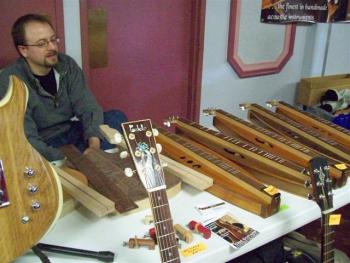
The Factory Tour: First and foremost - it is free, and takes nearly an hour. There are low end instruments hanging on the wall to play while you await the next tour and a high end room accessible by asking inside the 1833 shop. (gift shop - more about it later) The tour, as you would expect is excellent. The first view of the factory floor is from a platform overlooking a field of CNC machines. Everything is temperature and humidity controlled for stability and longevity of the finished product. I’m a quality geek, so I ask about everything. Our guide was more salesman than engineer, but he did his best to answer based on his 35 plus years with Martin.
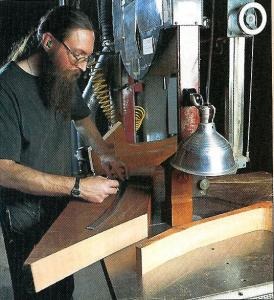
♪ As we continued on the tour I was increasingly surprised by the amount of hand craftsmanship that is used. Many places where I expected to see things machine cut, shaped or fabricated, they were being hand shaped, fitted and assembled. We were guided past many work stations fabricating their “Golden Era” and “Marquis” - built to pre-war specs and MTO (made to order) models all using traditional methods to give us the emphasis on hand craftsmanship. We saw manual band-sawing of necks, hand scalloping of braces, manual neck shaping and even manual heat bending of body sides. Gluing of backs, sides, fingerboards, necks, bindings, purfling and inlays is all hand done. Clearly they cannot use these methods on all models or they would not have gotten to their one millionth guitar (achieved in 2004). However, there is an incredible amount of hand craftsmanship in every one of the high end and even medium and lower priced Martins. Finish and buffing operations for most models was automated. Martin uses nitrocellulose lacquer which they contend is the least intrusive on tonal quality. They now also have a line of low end Martins (fabricated in Mexico I believe) that are Made of High pressure laminate (HPL) back and sides with either HPL or Sitka spruce tops. Most of these have a photographic wood finish and look, play and sound very nice.
The High End Room: After the tour I could not resist the high end room. This was both enjoyable and disappointing at the same time. Hanging on the wall in this acoustically neutral room were about a dozen unique Martins. Most were signature models for various artists, based on either the D-35 or D-45. One that caught my fancy was a Roger McGuinn D-7. I believe it was a D-35 base but there was an extra G string (an octave pair like a 12 string, but only on the G). Easy to play and has most of the complexity of a 12 string. The another attention getter was a Ditson D-111. Purely based on sound, since it has a 12 fret neck although a good feel to it. I think it had the liveliest set of strings in the room also, and that was where some of the disappointment came in. Most of the instruments were in need of some TLC. Dead strings were ubiquitous. The Johnny Cash model was even missing a string. They were all bearing a bit too much finger oil for my taste and needed more frequent cleaning. I actually sent an email to Martin, thanking them for a wonderful tour but also to comment that this is not the impression that they want to leave with the people interested in the high end room.
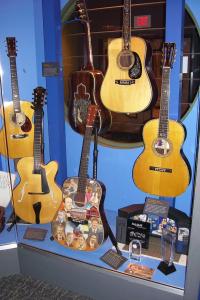
The Museum: Next we visited the museum. It is organized to go clockwise through time with displays, photos and instruments from 1796 to the present with a lot of special instruments and memorabilia from various artists throughout their history. Last display case has both the one millionth Martin and the 175th anniversary edition - a magnificent pearl peacock on the back. Don’t plan less than an hour in the museum - I think we spent two - fascinating history.
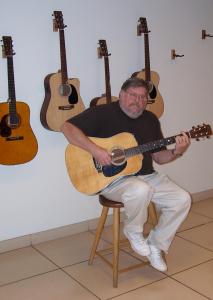
The gift shop: Last stop was the 1833 shop. You can’t buy a guitar there, but there is a ton of Martin gear, shirts, jackets, sweats, hats, strings, picks, books, CDs, parts and tools. You could spend the price of a new Martin and still not have one, but chances are you won’t leave empty handed. Great tour, great museum, great gift shop, great experience - highly recommended!
—Jerry Carter
Share this page: ![]() Facebook
Facebook
![]() Del.icio.us
Del.icio.us
![]() StumbleUpon
StumbleUpon
![]() Digg
Digg
![]() Reddit
Reddit
Home ::
About Us ::
Events ::
Articles ::
Resources ::
Contact Us ::
Links
©2007-2008, Rochester Guitar Club, All Rights Reserved, This page last updated 2010-02-27 11:29:31
Website by Red Beagle Web Development.








